Text

20/03 It's spring! The kiwi vines are awake!
Last year we ordered some kiwi vines to help control temperature in the dome. They'll climb up the south side of the dome and offer some partial leafy shade in summer, but let the sun in during winter when they've dropped their leaves.
Kiwis have male vines (which create pollen) and female vines (which bear fruit). We ordered one male and five females, but somehow received five males and one female, so the kiwi vines are enacting some sort of Vegetal Reverse Harem Anime.
#daily#kiwi#spring#vegetal reverse harem situation will get way more confusing when we start grafting from the female onto the males
77 notes
·
View notes
Text

20-03 Enormous Feathery Accountant
The Blue Haired Girlfriend and I sometimes say that the Enormous Feathery Accountant is the most sensible of our three Accidental Roosters, which is true, but only in the way that "Mercury is the planet in our solar system that most resembles a 1989 Suzuki GS500E motorcycle" is true.
Still, the Enormous Feathery Accountant usually only crows when Something Is Wrong, and we usually go outside and try to Fix The Wrong Thing. Sample Wrong Things:
The chickens have kicked sawdust into their feeder and can't see their food
The chickens have tipped over their waterer with ill-advised hijinks
A negligent human moved the feeder three centimeters North of the exact geometric center of the henhouse
Someone is going to town at the wrong time of day
It cannot currently be mathematically proven that another rooster doesn't exist, somewhere in the universe
A junco is eating the chicken food
A junco is drinking out of the water dish
A junco is sitting on the Enormous Feathery Rooster's favourite perch
The Enormous Feathery Accountant was making a racket today, so I went out and removed some sawdust from the feeder, re-centered it, and patiently explained that there had been no recent major mathematical breakthroughs on the Nonexistence Of Other Roosters.
The Enormous Feathery Accountant continued to yell, so I gave up and headed back toward the house, shouting over my shoulder in the general direction of the henhouse that I was still not able to delete all juncos from the world, and could the Enormous Feathery Accountant please █████ ████████ █████████████ cram it?
So anyway, as I came out from behind the woodshed, I saw what the Enormous Feathery Account was yelling about: some nice young missionaries, who had for the first time in the six years we've been living here, braved the long steep dirt road to invite us to Easter. Oops.
113 notes
·
View notes
Text

18-03 The weed situation in the geodesic greenhouse dome is totally reasonable. Evolution sends us so many very normal friends.
141 notes
·
View notes
Text
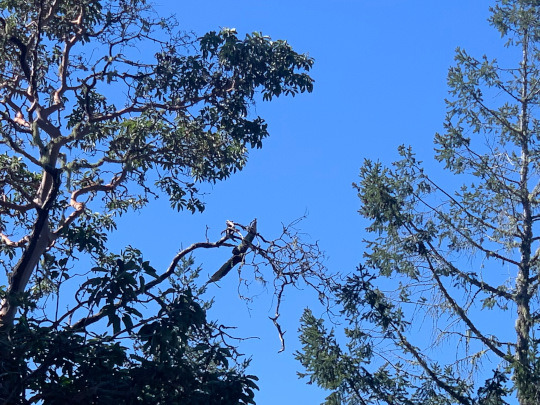
17-03-2024 Vulture.
The turkey vultures spend the winter in Venezuela, fly North along the mainland, and circle in groups above the shoreline. In the air they mostly lock their wings open and glide, not flap. So where the land ends they must circle at the water's edge and wait for the wind to be right to glide across to the islands in a group.
For months there have been no vultures, and then suddenly yesterday the wind opened their way home and the island's whole population is here, all at once. It's like someone found a giant knife switch labeled "Vultures" in a cave and shoved it to "on" with a satisfying "KA-VULTURE" sound.
The house is perched atop a stony ridge. The sun falls on the bare dark glacier-scraped slope behind the house and warms the stone, and from the warm stone a column of warm air rises. The vultures enter this invisible pillar of air and circle around its edges, upwards, upwards, around and above the house on ink-dark wings that glow where the sunlight comes through the edges of the feathers.
Sometimes they leave this air-column and glide over to the next stone ridge, the next invisible column of air, and the next beyond it, the next beyond that. Watching the vultures trace out the locations of the pillars, you get a sense of a whole vast structure of warmth and wind, like some grand invisible temple rising hundreds of meters into the bright brazen sky.
It's always here, I think, the huge columns, the invisible temple the glaciers built, made of air and light. But I can only see its structure when the vultures trace it out for me, like architectural drawings. Glad someone found the KA-VULTURE switch this year.
#daily#turkey vulture#cathartes aura#every spring i get all itchy and restart the chore blog#then by autumn i feel buried by how far behind i am and give up#it's spring apparently now#sad I was still hibernating for boop day though#vulture were actually back 16/03 but I didn't have a camera
117 notes
·
View notes
Text
12/05/2023 I have news so momentous that it can only be shared via the Destiel meme. The Forms Must Be Observed.

Dijon's Grainy's favourite snoozing spot is in the tray full of tachibana seedlings. She enjoys watering time, climbing things, eating pine borer beetles bigger than she is, and geodesic polyhedra.
#daily#frog#dijon grainy#dome#destiel news#pseudacris regilla#the forms must be observed#happy to report from several months in the future that we get to use the “dijon grainy” tag a bunch more#our greenhouse shelves are from a remodeled restaurant#hence the great labels
222 notes
·
View notes
Text

09/05/2023 We are normal, nonhazardous chickens. You can trust us around your delicious succulent fingers.
199 notes
·
View notes
Text

08/05/2023 Generally speaking, I enjoy how otherworldly the dome is. The way the skin of the dome focusses sound so your own footfalls come to you from a meter or two away from you unless you stand in the exact center. The way the dome bends wind around itself, so you can stand in motionless air and watch all the trees bow away from you. The iridescence of condensation on its skin.
However, this week the dome has decided the otherworld it wants to be is Venus. We've hit fifty degrees twice.
The Blue Haired Girlfriend, the Bearer of the Jabberwock Tattoo (staying with us and helping out over the summer), and I have been taking turns opening all the dome doors for ventilation and standing guard outside it to keep hungry chickens out.
Here is an experience you can have in the Imitation Venus Dome: Human skin uses several different ion channels to detect heat. If the air is 36 degrees, TRPV4 wakes up and sounds off like "yeah, it's kinda warm here." If it gets warmer, TRPV4 just gets louder. Same nerve signal, but more and more of it.
But at around 45 degrees, a new challenger appears. TRPA1 wakes up and sounds off, and it's Different. This is the channel fooled into going off by the capsaicin in hot peppers, put to its intended use at last. If, like me, you have mostly lived in pleasantly ocean-cooled climates, this is a New Experience. It's warm... it's warmer ... it's even warmer ... it's ẅ̷͉̟̰́͜a̸̯̥̰̭̘̭̝̺̯̿̓̀̒͂̊̐ȓ̷͎̓͐̋̽̕ṁ̵̥͇͖̝̱̳̻̊̀͋̂̓́̊̏̂͆̆͗͌.
#daily#dome#there are way more thermoceptors than that but this post is long enough already#we thought we had a couple months to figure out ventilation#we were wrong#now with correct date
117 notes
·
View notes
Text

06/05/2023 Caterpillar making Nonstandard Life Choices.
Marmara arbutiella is a tiny caterpillar that lives inside arbutus leaves. It leaves the waxy top and bottom layer of the leaf intact for shelter and eats a tunnel through the juicy middle layer, writing a gleaming silvery spiral into the flesh of the leaf.
The Blue Haired Girlfriend found this Caterpillar of Nonstandard Life Choices living in a salal leaf instead of an arbutus lead. These eccentrics turn up occasionally in a small area that includes our island.
We know the salal-dwellers are Marmara arbutiella, because someone sent a salal leaf with a caterpillar in it to Charley Eiseman (see @lies's Charley Eiseman Appreciation Post) and he got it DNA barcoded.
But nobody has observed a salal-dweller outside the leaf. We don't know if it has morphological differences from the arbutus-dwellers as an adult moth, like maybe a new subspecies is starting to branch off here.
So we picked the leaf and put it in a jar with a little moss to hold moisture. Hopefully there's still a Caterpillar of Nonstandard Life Choices in it, and the caterpillar will crawl out of the leaf, make a cocoon, and emerge into an adult we can send to Charley Eiseman.
The cocoon is pretty exciting too, described in the poetic words of Wagner, Loose, Fitzgerald, De Benedictis, and Davis:
The larvae exhibit a fascinating cocoon-spinning behavior which involves prolonged ornamentation of the cocoon with dozens of anally extruded compartmentalized bubbles, each of which is individually wrapped in silk and pushed through to the outer cocoon surface.
I, for one, am delighted at the prospect of a cocoon containing a moth nobody has ever seen, festively garlanded in silk-wrapped bug farts.
#daily#leaf miner#marmara arbutiella#moth#another fine post about animal poop#animals farts really but I don't have a tag for that#spoilers from future everwest: caterpillar had already left leaf#we did not get to see a fart cocoon or nonstandard life choices moth
145 notes
·
View notes
Text
nominative determinism
05/05/2023 It seemed like a good idea at the time.
When we have chicks, we give them descriptive nicknames based on their transient baby spots and stripes. As they grow up, they earn real names based on their devotion to a particular teaching of the mystic arts of Galline Derangement.


One of the batch of chicks eight months ago was yellow, except for a white face and black marks around the eyes. She looked like she was wearing clown makeup.
I didn't want to nickname her "Clown" or "Mime." I wanted to Be Clever About It. So her hatchling nickname became "Homestuck" because I was on tumblr a decade ago when everyone was posting fanart of Homestuck characters with clown makeup.


Today the chickens were making a terrible racket in the henhouse, and I ran out to investigate, and discovered that one of the hens had gotten inside the henhouse wall somehow and couldn't get out.
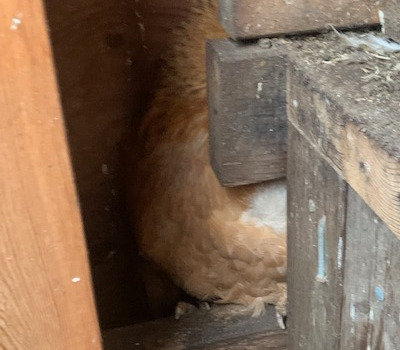
She was, uh, you know. She was... stuck. In her ... home. Guess who it was. Guess.
I got my arm into the wall and tried to support her, which calmed her. I tried lifting her up and out, but there was a crossbeam in the way. I tried guiding her downwards, but she panicked and kicked her feet the instant I wasn't holding her up.
After half an hour of trying to manually thread individual chicken atoms (all of which were screaming) between the wood atoms of the wall, I went to fetch a hacksaw. When I returned, she was standing innocently on the floor of the henhouse, eating a moth she apparently found in the wall.
As she apparently took her hatchling name as a suggestion, she gets to keep it. Presenting the newly christened Homestuck Q. Clipping-Error the Chicken.
#daily#chicken#the vague and polite suggestions of physics#homestuck#a young hen stands in her henhouse#though it was eight months ago she was given life#it is only today she will be given a name#homestuck by osmosis#the first draft of this post was a parody of The Naming of Cats but I couldn't quite get it to work
950 notes
·
View notes
Photo
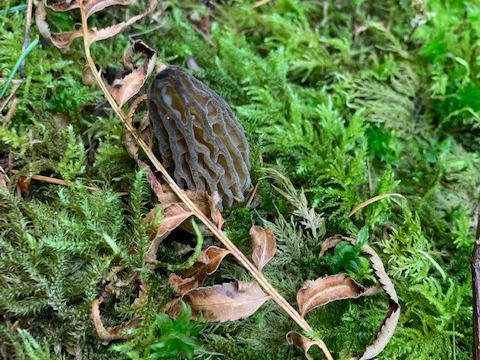
04/05/2023 The Blue Haired Girlfriend spotted a couple morels while we were walking down to the mailbox. Delicious! We've never seen morels here before.
Every year, in spring and autumn, when the light comes through the rain in a particular way, we go through a process foragers sometimes call "getting your mushroom eyes." At first you look at pieces of the forest one after another: the shadow of a likely tree, a mossy hollow, a fallen log, a pile of rotting leaves. Mushrooms could be in this place, or that one, and you focus on each possibility one at a time, switch between them with a sort of internal click. But as the rains continue and the world greens, we start to read the forest as a whole story, instead of sounding out each individual shadow and clump of moss. There's a trick to it that has to be relearned each season, a porousness, a way of looking at the world and letting it flow through you and feeling the underlying currents and patterns.
Until one day you are walking in the woods and there are mushrooms everywhere and it doesn’t seem possible you didn’t see them before. Like you've gone through a hidden doorway into a different world, stranger and truer than the old one.
The thing that is most like getting your mushroom eyes is falling in love. You meet someone. A musician: you talk about synthesizers and phrygian mode. You look at the moon together when you are sleepless thousands of kilometers apart. You've never been good at conversation, but she listens to everyone - waiters and tow truck drivers and delivery people - and you learn that everyone has a story so beautiful that listening to them tell it feels like wings opening inside your ribcage. At first the glimpses of the other world are piecemeal, clicking into and out of focus - like maybe you hear a synthesizer in grocery store background music, and you tell your friends, "hey, you know, my girlfriend is a musician," and they smile tolerantly. (It is not the first time they have heard this.)
Until one day you realize you can feel the phase of the moon without looking at it, the mode of a song is as clear as its lyrics, and that when you talk to a stranger you can see a soft light in them now, like a lantern through stained glass. It doesn’t seem possible that you didn’t see these things before, somehow. You have come through the door of her, to a better world, vaster and stranger and truer.
We enjoy cooking, but I think more than the occasional leaf or mushroom for the kitchen, the thing we love about foraging is to love the world, together.
#daily#morel#morchella importuna#mushroom#mushroom eyes#rank sentimentality#the blue haired girlfriend#posts i think are a good idea when I've had two hours' sleep#i have not been posting for three years and I am a little drunk on how many words there are in the world
223 notes
·
View notes
Text

03/05/2023 Rumbled! In our defense, if the chaotropic tumblr hivemind had voted for the Eight Foot Tall Jagged Iron Torus, Constructed For Unknown Purpose, Free To Good Home, but we'd been unable to procure it, tumblr might have been Very Disappointed In Us. So I put the poll in while the torus-bearing crane truck was pulling up the driveway.

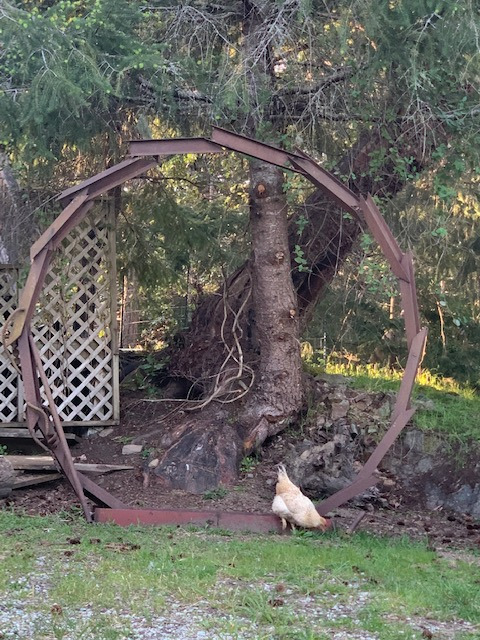
Details photographed the next day, in fog.



While we were cleaning out the cracks, we found dried out little segments of rose cane, and beneath them, twisty honeysuckle tendrils. Apparently the Eight Foot Tall Jagged Iron Torus, Constructed for Unknown Purpose, Free To Good Home instills in everyone who sees it the intense desire to grow climbing plants on it.
Some dark day perhaps we will all finally know and rue the Purpose of the Eight Foot Tall Jagged Iron Torus, Free to Good Home. But in the meantime, it sleeps under a curling green blanket and dreams of blossom and berry, lifting sunwards.
4K notes
·
View notes
Text
4K notes
·
View notes
Photo

19/11/20 Bleeding Fairy Helmet mushrooms, which seep a red liquid when injured, growing out of the stairs up to the house. I’m sure it’s fine. The stairs are structurally sound and totally not cursed.
230 notes
·
View notes
Photo
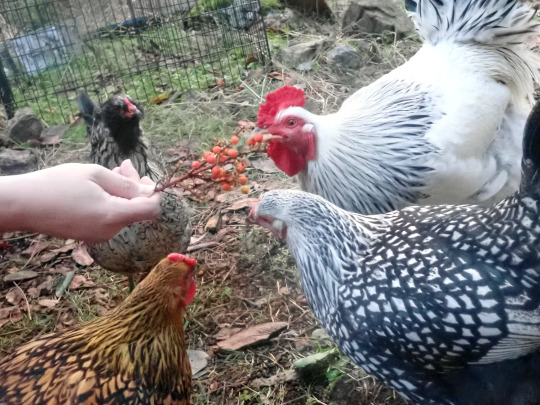
16/11/2020 The Accidental Rooster is starting to attempt Rooster Things. Today's plan: 1) find bright coloured berry, 2) feed bright coloured berry to hens, 3) profit.
The plan was not a success. The hens already have bright coloured berries. So they ignore the giant cooing fluffy thing following them around and dropping berries on their heads.
150 notes
·
View notes
Photo

14/11/2020 A Barred Owl has been making Confused Sex Hoots. In the middle of the day. In November, which is the least sexy month for Barred Owls. We found this Mystery Lump in the forest, looking like a lopsided glob of molten marshmallow about to fall off the skewer. Can't be sure at this distance, but I suspect the Mystery Lump is the source of the Confused Sex Hoots.
Consider the Arctic Terns. They live in a world of brightness, crossing the globe twice a year to live on the gleaming ice under the nightless skies of both the Arctic and Antarctic summers. Winter does not know them, and they nod vaguely and politely when you speak to them of night.
Consider the Bar-headed Geese, who have been migrating across the Himalayas since before the Himalayas existed. Their blood is strange with mutant hemoglobin. They cross in a single night, in dark and bitter cold, so the air above the mountains thickens enough to hold them.
And then there's these guys. Scientists have captured, banded, released, and recaptured a couple hundred Barred Owls; none was further than ten kilometers from its starting point. They are the laziest bird.
#daily#barred owl#owl#i have no idea how barred owls got to this island#they somehow spread from the east to the west cost of North America over about 100 years#science is unclear how that happened#science is also unclear on how I am almost a year behind now#i am not good at blogging
227 notes
·
View notes
Photo

09/11/2020 Candlesnuff fungus.
The pale sections of this species bioluminesce green, but it’s quite faint. The Ominous Grasping Hands Clawing Their Way Out of the Earth, Shining With An Eldritch Light are only visible on moonless nights.
Or so I’ve read. Somehow this species seems to have evolved to only glow whenever I, specifically, am not around. Sigh. I never get any Ominous Grasping Hands Clawing Their Way Out Of The Earth, Shining With An Eldritch Light.
169 notes
·
View notes
Text
On a post about the Blue Haired Girlfriend's quixotic citrus breeding experiments, @voidingintotheshout asked:
I mean, if you wanted a hearty citrus relative, why didn’t you just grow Osage Orange? They can grow as far north as Michigan which is surely further north than anyone could reasonably expect to grow a citrus tree. They’re not edible but then hearty orange isn’t either. Osage Orange are so cool and such a interesting historical plant from the Shelterbelt era of American agriculture. Apparently they do smell like citrus.
This is part three of three. Part one. Part two.
Now you've done it! It's time for A Very Brief (But Also Insufficiently Brief) History of Twentieth Century Hardy Citrus Cultivation! Growing citrus trees this far north is kind of nuts, it's true, but I promise you it is not even close to the weirdest things people have done to grow citrus in places where the citrus doesn't think it should grow.
A note: This post will written using the Swingle citrus taxonomy system, including things that are definitely wrong. The citrus taxonomic tree looks like that one box of orphaned computer cords I keep moving with me to new houses "in case I need them" except some sort of adorable five-dimensional kitten has entertained herself with them and some of the resulting knots are not technically possible in our space-time continuum.
The powers that be gave us citrus because nothing pleases them like seeing a geneticist cry.
1. The Migrant Trees
The Soviet Union wanted lemons for tea, and they wanted to be independent enough not to have to trade with anyone else to get them, which meant they wanted to grow their own citrus. That part of the world is not a great place to grow plants that die when the temperature goes below zero, but at the foundation of the Soviet Union, there were citrus orchards in the warmest part of Georgia, along the Black Sea. Specifically, there was about, uh, one and a half square kilometers of somewhat implausible citrus orchard.
Hang on, it is about to get way less plausible.
This is the great citrus migration: any tree that did well in one spot, they'd try planting its seeds a few kilometres further north, or a few kilometres further east. Prizes were offered for breeding hardier citrus. Slowly the orchards spread, but they were extremely weird orchards.
It's usually a few degrees warmer at ground level than up in the air, and there's way less wind. So as the trees grew, they were bent over and tied along the ground. Some of them had the central trunk run in a straight line along the ground, with branches spreading out from it like the leaves of a fern, like an espaliered tree on its side. Others were starfish shaped, with the central trunk looped down until it ended up next to the base, and the branches sprawling out along the ground from the centre like starfish legs. The citrus trees were no taller than particularly vigorous strawberry plants, but they survived the winters, and you could throw a blanket over them to help them stay warm.
None of that helped if the ground froze solid, so they needed Underground Citrus. You'd dig a ditch, down below the lowest area where the ground froze, and you'd plant flat Starfish Trees or Flat Frond Trees running along the bottom of it, too deep to freeze. In winter, you'd just cover the ditch with boards any time the temperature was expected to go below freezing - citrus would tolerate the lack of light, but not the cold. Mandarins (Citrus reticulata) seemed to do best, so that’s most of what was grown.
It is a nearly unimaginable amount of work to grow citrus this way, along the bottoms of pits and trenches. We are experimentally trying to grow a Soviet-developed mandarin breed of unknown parentage, Shirokolistvennyi, but we will definitely not be putting in that level of effort.
2. The Mixed Up Trees
There are a couple species of citrus that tolerate cold well, but taste awful. A lot of effort has gone into crossbreeding them with more edible citrus. The results are ... mixed.
The Ichang Papeda (Citrus cavaleriei) generally survives temperatures down to -18 degrees C. It is stoic and calm and has mastered emptiness. Unfortunately, it has mastered emptiness too well. The fruit smells like lemons, with maybe a hint of rose, but there's nothing to eat here. It has a rind and seeds. No juice, no flesh.

(Photo by Michael Saalfield)
The Ichang Papeda is the parent or grandparent to several delicious, extremely sour Asian citrus types. Yuzu/yuja smells like grapefruit and clean wet stones from the bottom of a fast-flowing stream. Sudachi smells like grapefruit and leaves with dew on them. (I haven't met kabosu or any other papeda hybrids personally, but they are numerous.) They're all too sour to eat plain, unless you really need to turn your face inside out for some reason, but make for excellent flavouring.
(We have a yuzu tree and a sudachi tree and they're surviving, but no fruit yet.)
Trifoliate orange (Poncirus trifoliata) can survive temperatures down to -30 degrees C. This may be partly because, uniquely amoung citrus, they can drop leaves in autumn or winter and regrow them in spring, like a maple tree. They also produce an internal antifreeze. They are angry, twisted, thorny little plants that yell swears when you walk past them. They make a great hedge. The fruit is furry, smells like flowers and pine trees and taste like burnt, bitter plastic. It may or may not be possible to breed the horrible taste completely out of trifoliate oranges without losing cold-hardiness, if it's due to their antifreeze chemicals. Here’s Stabby:
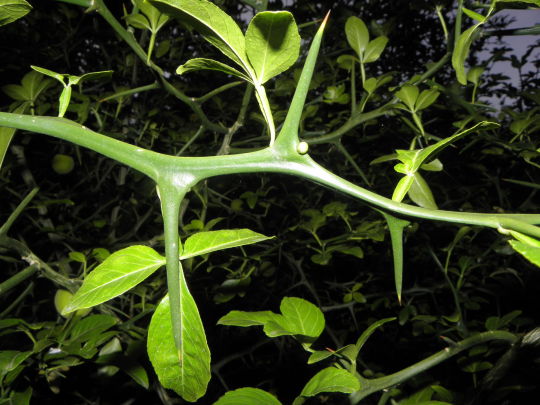
(Photo by Rob Hille)
Even the least terrible trifoliate crossbreeds are bitter enough to qualify as “acquired tastes.” There are recipes for trifoliate marmalade: put a dozen trifoliate oranges, a kilogram of sugar, and a kilogram of pebbles in a pot, cook until it gels, then sieve out the oranges and eat the pebbles.
We are growing a trifoliate orange / minneola orange hybrid. And, of course, someday our own trifoliate hybrids. The Blue Haired Girlfriend planted 200 trifoliate oranges a couple years ago. There are fewer now, but the survivors have lived through two winters of snow and frost, and they might have somehow gotten more stabby. We're going to breed them, to each other or to less angry fruit, try and make something new and good from them.
I've limited this post to twentieth century hardy citrus breeding, but I have to give a shoutout to somatic hybridization, a decidedly twenty first century technique, where you take a cell from each of two different plants, remove their cell walls, put them next to eachother, and shock them with electricity until they merge into a single cell whose nucleus contains all genes from both plants. Then the new plant is like, "Wow, I guess these are all my genes? It seems like a lot, haha, but it's not like somebody made me from dismembered body parts and electricity, that is not how science works. Anyway I guess it's time to do some plant stuff now."
3. The Mutant Trees
In the 1950s, people started using radiation to randomly scramble the genes of plants. You'd irradiate seeds enough to change the genes somehow, and then you'd have to plant them to see what had happened. Maybe it was people horrified by the atomic bomb desperately wanting to find some life-supporting use for atomic fission, maybe it was government-supported cold war "atom bombs are good actually, look how many we have, USSR" propaganda. Probably both.
This time period also saw serious plans for Orion, a spaceship with a huge metal plate for a butt, intended to be propelled by exploding atomic bombs under it, which I am not actually making up.
Thousands of people in Europe and the US signed up to receive seeds with random mutations in the mail, plant them, and report back on what they heck they grew into and if it had any useful weirdness. (The gamma radiation used to mutate the seeds did not make them radioactive themselves - the seeds were completely safe.) There were also more formal and carefully controlled university research programs in China, Japan, and the US, where plants where grown in a circular research garden with a coverable radiation source at the centre, so that the farther you got from the centre, the less radiation the plants got. Radiation breeding is less popular than it used to be, but Japan still has a very productive citrus radiation breeding program.
The most popular radiation-bred citrus is the "Rio Red" grapefruit and its offspring, which has a much deeper red than non-mutant red grapefruit.
There aren't many radiation-developed citrus breeds noted for cold-hardiness - with radiation you get whatever you get - but there are a few, and I want one just because I think they're neat, a monument to that lovely human vision that looks at terrible weapons and somehow sees glossy-leaved trees with bright fruit.
4. The Monster Trees
Citrus are usually grown via grafting. That is, you plant a seed from a fast-growing sturdy breed, you let it grow roots and all that, and then you cut the top off and replace it with a branch from a more delicious breed. The two citruses grow together, and you end up with a tree that's disease and cold resistant in the roots, below the graft, but makes tasty fruit above the graft.
Occasionally, this process goes Wrong.
The first recorded instance is the tree called Bizarria, discovered in 1640. Someone attempted to graft a sour orange branch onto a citron. But instead of a clean line between sour orange branches and citron roots, the graft was damaged somehow, and the two different species of cells got tangled and mixed through the whole tree. It has branches that produce citron fruit. It has branches that produce sour orange fruit. And it has branches that produce, uh ... these:

(Photo by Labrina)
Most graft chimeras are made accidentally, when the graft site is damaged. Trifoliate orange is often used as rootstock, so there are many reported chimeras involving trifoliate orange and a nicer fruit. The mixed-up cells can be arranged a lot of ways, but it's possible to have the outside layer of the tree be trifoliate orange, and the core of the tree be the other citrus (periclinal chimera). This means you could theoretically get a tree with frostproof trifoliate leaves and branches, but fruit that doesn’t taste like burnt plastic rolled in quinine.
This lucky monstrosity has, in fact, reportedly happened. Twice. There is the Prague Citsuma, discovered in a greenhouse in Prague and suspected to have been created by a Soviet breeding program. And then there is the Hormish, discovered in China and thought to have been made by frostbite messing up the clean lines of the graft. The Blue Haired Girlfriend has managed to track down budwood from the Prague Citsuma - I’m so excited! - so we'll see how the fierce thorny monster tree with a heart of gold, or at least heartwood of gold, does for us.
5. Conclusion
Humans have been trying to grow citrus trees where they don't belong for nearly two thousand years, at least since the Jewish Diaspora and people trying to grow holy etrog trees - trunks gnarled as barnacle stones and the whole tree scented like the best dream you can't remember - in Europe. Maybe longer.
The Blue Haired Girlfriend's citrus-breeding schemes aren't going to singlehandedly transform Canada into a net citrus exporter. But history shows us: it might be possible to have a little gleaming sweetness from the stony ground here, with the ravens and the fir trees and the auroras. A sweetness we made ourselves, that exists nowhere else.
Or maybe we'll just have a bunch of weird inedible fruit. I don't know, but it's worth finding out, worth weaving together leaf and thorn and stone and the light of our hands as the years unwind. Worth it to have a quixotic project we can expect to spend decades on together, hands and hearts. This is how home is made, sometimes, with a balcony full of angry thorny little trees that shout swears at passerby.
#part three of three#so much doesn't fit in this post#fog gardening#how lemons started the mafia#etrogs in diaspora#citropsis and the african citrus species#we are still discovering new citrus species in oceania!#who knows what we'll make?#and one day we'll scoop up hydrocarbons from Titan's stormy seas and polymerize them and make huge bubble greenhouses filled with citrus#small children will fling squishy citrus at their siblings by the coiled light of Jupiter#which is as it should be#thank you voidingintotheshout for an excuse for all sorts of ranting
835 notes
·
View notes